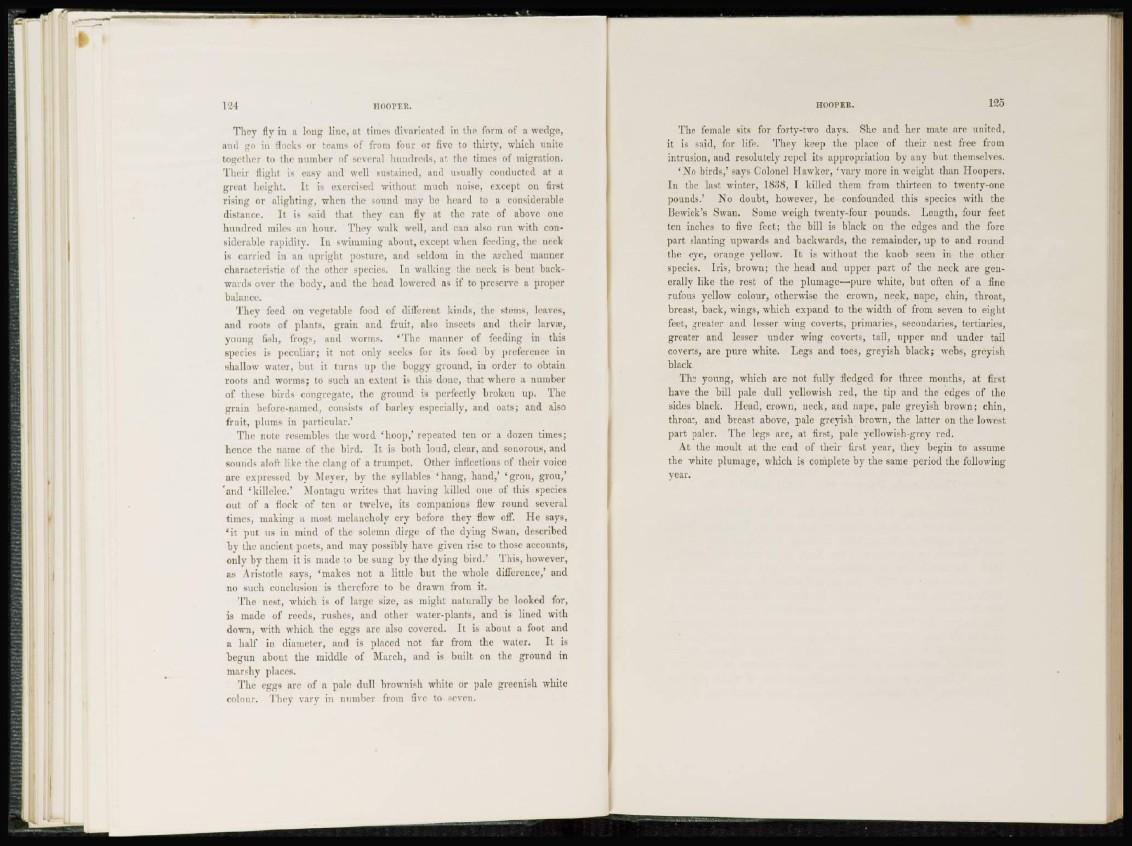
They fly in a long lino, at times divaricated in the form of a wedge,
ami go in flocks or teams of from four or five to thirty, which unite
together to the number of several hundreds, at the times of migration.
Their flight is easy and well sustained, and usually conducted at a
great height. It is exercised without much noise, except on first
rising or alighting, when the sound may lie heard to a considerable
distance. It is said that they can fly at the rate of above one
hundred miles an hour. They walk well, and can also run with considerable
rapidity. In swimming about, except when feeding, the neck
is carried in an upright posture, and seldom in the arched manner
characteristic of the other species. In walking the neck is bent backwards
over the body, and the head lowered as if to preserve a proper
balance.
They feed on vegetable food of different kinds, the stems, leaves,
and roots of plants, grain and fruit, also insects and their larv;c,
young fish, frogs, and worms. 'The manner of feeding in this
species is peculiar; it not only seeks for its food by preference in
shallow water, but it turns up the boggy ground, in order to obtain
roots and worms; to such an extent is this done, that where a number
of these birds congregate, the ground is perfectly broken up. The
grain before-named, consists of barley especially, and oats; and also
fruit, plums in particular.'
The note resembles the word 'hoop,' repeated ten or a dozen times;
hence the name of the bird. It is both loud, clear, and sonorous, and
sounds aloft like the clang of a trumpet. Other inflections of their voice
are expressed by Meyer, by the syllables 'hang, hand,' ' grou, grou,'
"and 'killelee.' Montagu writes that having killed one of this species
out of a flock of ten or twelve, its companions flew round several
times, making a most melancholy cry before they flew off. lie says,
' i t put us in mind of the solemn dirge of the dying Swan, described
by the ancient poets, and may possibly have given rise to those accounts,
only by them it is made to be sung by the dying bird.' This, however,
as Aristotle says, 'makes not a little but the whole difference,* and
no such conclusion is therefore to be drawn from it.
The nest, which is of large size, as might naturally be looked for,
is made of reeds, rushes, and other water-plants, and is lined with
down, with which the eggs are also covered. It is about a foot and
a half in diameter, and is placed not far from the water. It is
begun about the middle of March, and is built on the ground in
marshy places.
The eggs are of a pale dull brownish white or pale greenish white
colour. They vary in number from five to seven.
The female sits for forty-two days. She and her mate are united,
it is said, for life. They keep the place of their nest free from
intrusion, and resolutely repel its appropriation by any but themselves.
' N o birds,' says Colonel Hawker, 'vary more in weight than Hoopers.
In the last winter, 1838, I killed them from thirteen to twenty-one
pounds.' No doubt, however, he confounded this species with the
Bewick's Swan. Some weigh twenty-four pounds. Length, four feet
ten inches to five feet; the bill is black on the edges and the fore
part slanting upwards and backwards, the remainder, up to and round
the eye, orange yellow. It is without the knob seen in the other
species. Iris, brown; the head and upper part of the neck are generally
like the rest of the plumage—pure white, but often of a fine
rufous yellow colour, otherwise the crown, neck, nape, chin, throat,
breast, back, wings, which expand to the width of from seven to eight
feet, greater and lesser wing coverts, primaries, secondaries, tertiaries,
greater and lesser under wing coverts, tail, upper and under tail
coverts, are pure white. Legs and toes, greyish black; webs, greyish
black.
The young, wdiich arc not fully fledged for three months, at first
have the bill pale dull yellowish red, the tip and the edges of the
sides black. Head, crown, neck, and nape, pale greyish brown; chin,
throat, and breast above, pale greyish brown, the latter on the lowest
part paler. The legs are, at first, pale yellowish-grey red.
At the moult at the end of their first year, they begin to assume
the white plumage, which is complete by the same period the following
year.